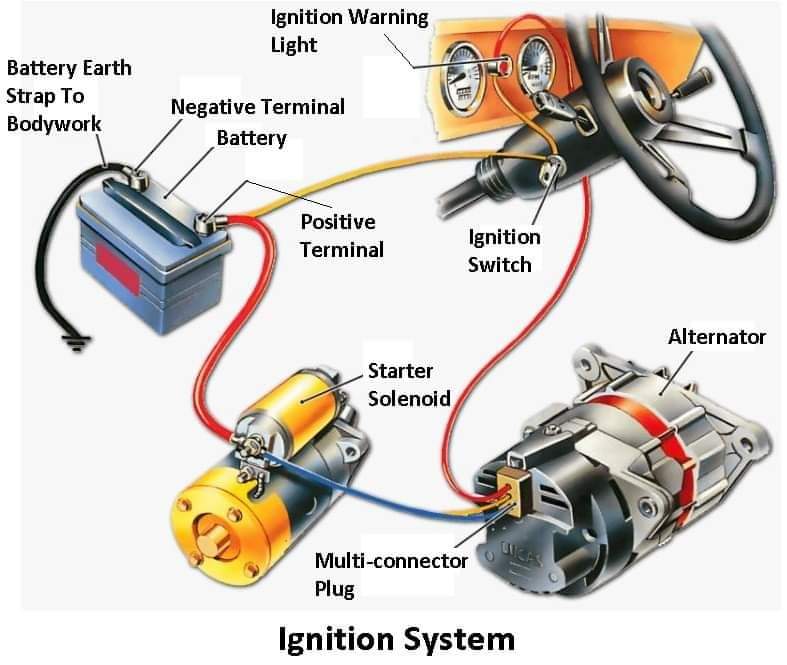Efficient Steps for Replacing Ignition System Components
Efficient steps for replacing ignition system components include identifying the faulty part, disconnecting the battery, removing the old component, and installing the new one. Replacing ignition system components is an essential aspect of vehicle maintenance.
Over time, these components can wear out or become damaged, leading to issues such as misfires or starting problems. We will discuss the efficient steps for replacing ignition system components. By following these steps, you can ensure smooth and reliable performance from your vehicle.
Identifying the faulty part is the first step, followed by disconnecting the battery to prevent any electrical hazards. Then, the old component needs to be carefully removed, making sure not to damage any surrounding parts. Finally, the new component can be installed, completing the process. Let’s delve deeper into each step to ensure a successful replacement of ignition system components.
Importance Of Ignition System Maintenance
Proper Ignition System maintenance is crucial for optimal vehicle performance. Replacing ignition components promptly ensures smooth engine operation and prevents potential breakdowns. Following efficient steps for component replacement can enhance overall driving experience and prolong engine lifespan.
Maintaining a well-functioning ignition system is crucial to the overall performance and efficiency of your vehicle. The ignition system, composed of various components like spark plugs, ignition coils, and the ignition control module, is responsible for starting the engine and powering it throughout your journey.
Enhancing Engine Performance
A properly maintained ignition system plays a vital role in enhancing the performance of your engine. The spark plugs, for instance, are responsible for igniting the air-fuel mixture within the combustion chamber. Regularly inspecting and replacing worn-out spark plugs can ensure optimal ignition, leading to better engine performance and power delivery.
Additionally, maintaining the ignition coils, which supply the high voltage needed to generate sparks, is essential for efficient combustion. Faulty ignition coils can result in misfires, reduced engine power, and even engine stalls. By regularly checking and replacing faulty ignition coils, you can maximize your engine’s performance and prevent potential issues down the road.
Ensuring Fuel Efficiency
Proper ignition system maintenance is also crucial for ensuring fuel efficiency. When the ignition system is functioning efficiently, it ensures that the air-fuel mixture is ignited at the right time and in the correct proportions. This efficient combustion leads to better fuel economy, as the engine is able to extract maximum power from each drop of fuel.
Regularly replacing spark plugs at the recommended intervals ensures that the air-fuel mixture is ignited effectively, reducing fuel wastage and improving fuel efficiency.
Furthermore, a well-maintained ignition system prevents the occurrence of misfires, which can lead to incomplete combustion and fuel wastage. By taking the necessary steps to maintain and replace ignition system components promptly, you can optimize fuel efficiency and save on fuel costs in the long run.
Diagnosing Ignition System Issues
Diagnosing problems with your ignition system is the crucial first step towards efficient troubleshooting and replacing faulty components. Ignition system issues can cause a variety of problems, such as difficulty starting the engine, engine misfires, or poor fuel efficiency. In this section, we will explore two important aspects of diagnosing ignition system issues: identifying common symptoms and using diagnostic tools.
Identifying Common Symptoms
Before you can determine which components of your ignition system need replacing, it is essential to identify the common symptoms associated with ignition system issues. By recognizing these symptoms, you will be able to narrow down the specific problem and take appropriate action.
- Misfiring engine: If your engine is misfiring or sputtering during acceleration, it is a clear indicator of an ignition system problem.
- Difficulty starting the engine: If your engine is struggling to start or takes several attempts to turn over, it may be due to a faulty ignition system.
- Poor fuel efficiency: A decrease in fuel efficiency can be a result of ignition system issues, as they can affect the combustion process, leading to inefficient fuel burn.
- Inconsistent idle: An erratic or rough idle can signify problems within the ignition system, causing fluctuations in engine speed at idle.
Using Diagnostic Tools
To accurately diagnose ignition system problems, it is recommended to use diagnostic tools designed specifically for this purpose. These tools enable you to pinpoint the exact issues and identify which components require replacement. Here are some commonly used diagnostic tools and their benefits:
- Spark tester: A spark tester allows you to check if the ignition system is providing a strong spark to ignite the fuel-air mixture. A weak or no spark indicates potential problems with ignition coils, spark plugs, or ignition modules.
- Ignition analyzer: An ignition analyzer helps you analyze the performance of the ignition system components in real-time. It provides valuable data such as ignition timing, spark voltage, and firing sequences, enabling you to troubleshoot more effectively.
- Scan tool: A scan tool is a versatile diagnostic tool that can retrieve trouble codes from your vehicle’s onboard computer. These codes can offer insights into ignition system issues and help you determine the faulty components.
Preparing For Ignition System Component Replacement
Preparing for Ignition System Component Replacement
Gathering Necessary Tools and Parts
Ensuring Safety Measures
Gathering Necessary Tools And Parts
- Prepare new ignition components like spark plugs and wires.
- Get necessary tools such as a socket wrench and spark plug socket.
- Keep safety equipment like gloves and safety goggles handy.
Ensuring Safety Measures
- Disconnect the car’s battery to prevent electrical accidents.
- Ensure the engine has cooled down completely before starting work.
- Be cautious of hot engine parts to avoid burns.

Credit: www.facebook.com
Step-by-step Guide To Replacing Ignition System Components
In this step-by-step guide, we will walk you through the process of replacing ignition system components in your vehicle. Whether you’re a seasoned mechanic or a novice DIY enthusiast, these efficient steps will help you replace ignition system components with ease and confidence.
Locating And Accessing The Ignition Components
Begin by locating the ignition components in your vehicle. This can vary depending on the make and model of your car, so refer to the owner’s manual for specific guidance. Typically, the ignition system components are found near the engine compartment.
Once you have located the components, ensure that the area is clear of any obstructions and that you have ample space to work. If necessary, use a flashlight to improve visibility, especially if the components are positioned in a tight or concealed space.
Removing And Installing New Components
Before removing any components, make sure the engine is cool and the key is removed from the ignition. Start by disconnecting the battery to avoid any electric shocks or accidents. Then, carefully remove the old ignition components, such as the spark plugs, ignition coil, or distributor cap, using the appropriate tools.
Once the old components are removed, carefully install the new components in their place, ensuring that all connections are secure and each component is properly aligned. Take care to follow the manufacturer’s recommendations for torque specifications and any specific installation instructions to avoid damaging the new components.
Testing And Verifying The Ignition System
When it comes to ensuring the smooth operation of your vehicle, testing and verifying the ignition system is crucial. After replacing ignition system components, conducting post-replacement checks and ensuring proper functionality are essential steps to guarantee optimal performance. Let’s delve into the efficient steps for testing and verifying the ignition system.
Conducting Post-replacement Checks
After replacing ignition system components, it’s vital to conduct thorough post-replacement checks to guarantee everything is in proper working order. Here are some post-replacement checks that should be performed:
- Inspect all connections and wiring for any signs of damage or looseness.
- Verify that the ignition timing has been set correctly.
- Check for any fault codes using a diagnostic tool.
Ensuring Proper Functionality
Ensuring the proper functionality of the ignition system is paramount for the overall performance of your vehicle. After replacing ignition components, follow these steps to ensure everything is functioning as it should:
- Test the ignition system using a spark tester to ensure proper spark plug firing.
- Conduct a cylinder balance test to verify that each cylinder is contributing equally to the engine’s performance.
- Perform a road test to confirm that the vehicle accelerates smoothly and operates without any hesitation.

Credit: boilersinfo.com

Credit: www.reddit.com
Frequently Asked Questions Of Efficient Steps For Replacing Ignition System Components
What Are The Steps Of The Ignition Switch?
The steps of the ignition switch include inserting the key, turning it clockwise, and activating the electrical system. This action allows for the engine to start and begin the vehicle’s operation.
How Do You Change An Ignition?
To change an ignition, follow these steps: 1. Disconnect the car battery. 2. Remove any covers or panels around the ignition switch. 3. Disconnect the wiring harnesses and screws holding the ignition in place. 4. Install the new ignition by reversing these steps.
5. Reconnect the car battery and test the new ignition.
What Is The Procedure Of Ignition System?
The ignition system sparks the fuel-air mixture in the engine to start the combustion process. It includes spark plugs, ignition coil, and distributor.
Is Replacing Ignition Coils Easy?
Yes, replacing ignition coils can be easy with the right tools and knowledge. It involves disconnecting old coils and installing new ones. Cleaning and inspecting the connecting components is also recommended. Proper safety measures should be followed.
Conclusion
Following these efficient steps will help you replace ignition system components easily. Check your vehicle’s manual for specifics and remember to prioritize safety throughout the process. By maintaining a smooth-running ignition system, you can ensure your vehicle’s optimal performance and longevity.
